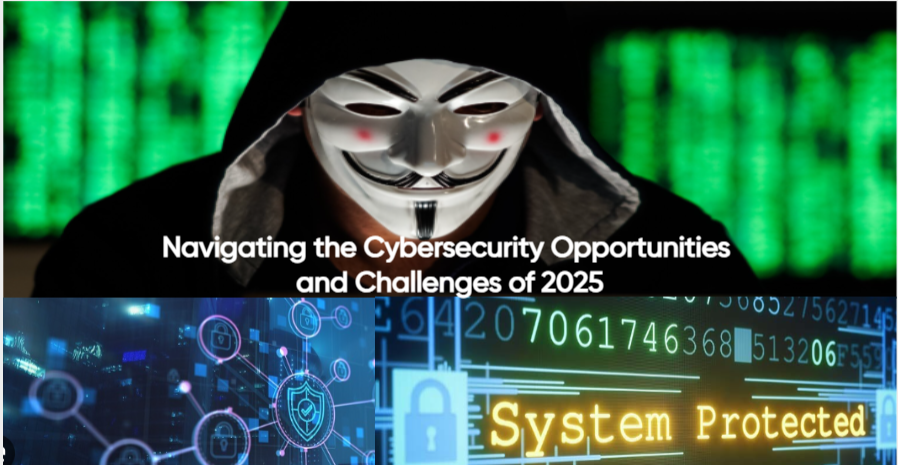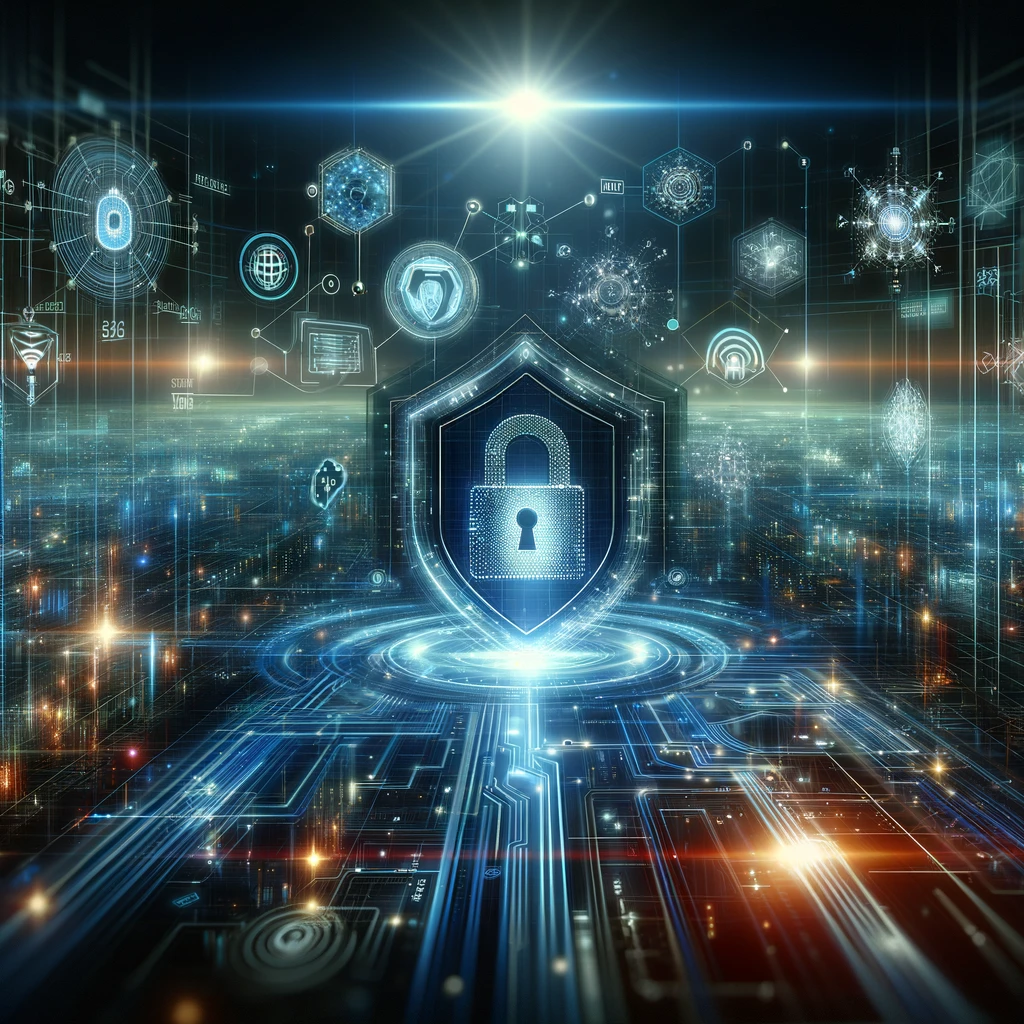Newness
Tech
Technology
AIAndCybersecurity, CloudSecurity, CyberDefense, CyberResilience, CyberRiskManagement, Cybersecurity2025, CybersecurityChallenges, CybersecurityInnovation, CyberThreats, DataProtection, DigitalSecurity, EmergingTech, FutureOfCybersecurity, latest, news, PrivacyProtection, SecurityTrends, ThreatIntelligence, trending
Manish sonawane
0 Comments
Navigating the Cybersecurity Opportunities and Challenges of 2025
1. Introduction
Importance of Cybersecurity in an Increasingly Digital World: As businesses, governments, and individuals become more reliant on digital systems, the rise in online transactions, cloud storage, and connected devices creates more opportunities for cyber threats.
Rapid Technological Advancements and Their Impact: Emerging technologies like AI, IoT, and 5G bring new benefits but introduce vulnerabilities. Security professionals must adapt to these changes to protect systems.
Purpose of the Article: This article outlines the key trends expected to impact 2025. Understanding these changes helps prepare for new threats and the evolving landscape.

2. The Evolving Threat Landscape
A. Rise of Sophisticated Attacks
AI and Machine Learning Attacks: Cybercriminals use AI and ML to create more adaptive and intelligent attacks, making detection and defense harder.
Increased Use of Ransomware and Malware: Ransomware and malware targeting critical infrastructure and businesses are becoming more sophisticated, making it difficult to trace and decrypt.
Targeted Attacks on Infrastructure: Industries like energy, healthcare, and finance are major targets for attacks aimed at causing disruption.
B. Threats to Emerging Technologies
Cyber Risks in IoT: The proliferation of IoT devices creates more entry points for attacks, as many lack robust security features.
Risks in 5G and Communication Technologies: 5G networks increase connected devices and data flow, but also create new vulnerabilities that require strong protection.
C. Data Breaches and Privacy Concerns
Increased Frequency of Data Breaches: As sensitive data is stored in more places, breaches are becoming more frequent and costly, particularly for personal and financial data.
Evolution of Privacy Regulations: Governments are enacting stricter laws like GDPR and CCPA, requiring companies to adapt to avoid penalties and protect consumer trust.
3. Key Trends for 2025
A. Artificial Intelligence and Machine Learning
AI/ML for Threat Detection: AI and ML help identify anomalies and threats in real time, improving detection accuracy.
Automation of Security: Automation of routine tasks allows security teams to focus on complex issues.
Use of Predictive Analytics: AI helps predict threats by analyzing past attack patterns, allowing organizations to strengthen defenses proactively.
B. Zero Trust Architecture
Shift Towards “Never Trust, Always Verify”: All users and devices, inside or outside the organization, must be verified before accessing resources.
Implementing Least Privilege Access: Users only have access to the resources they need, and their access is constantly monitored.
Role of Identity and Access Management: IAM solutions will be essential in enforcing strict access controls.
C. Cloud Security
Securing Hybrid and Multi-Cloud Environments: Securing hybrid or multi-cloud environments presents challenges that require consistent security solutions.
Cloud-Native Security Tools: These tools are being developed to address cloud-specific security challenges, like securing containerized applications.
Third-Party Risk Management: As businesses rely on cloud vendors, managing security risks in partnerships will be increasingly important.
D. Cybersecurity for Remote and Hybrid Workforces
Endpoint Security for Remote Employees: Securing devices used to access company networks remotely, including laptops and smartphones, is a priority.
Secure Collaboration Tools: Businesses will adopt secure tools for remote work and establish safe protocols for data sharing.
Protecting Personal Devices and Networks: Many employees use personal devices and home networks, which need strong protection with endpoint solutions and VPNs.
E. Blockchain and Cybersecurity
Blockchain’s Role in Data Integrity: Blockchain ensures secure, transparent records, making it harder for attackers to alter data.
Blockchain for Secure Transactions: Blockchain will support secure financial transactions, identity management, and decentralized access control.

4. Regulatory and Compliance Changes
A. Global Cybersecurity Standards
Introduction of Stricter Laws: Governments worldwide will enforce stricter cybersecurity, data protection, and privacy regulations.
Impact of GDPR, CCPA: Companies will need to navigate varying regional laws and ensure compliance to avoid legal penalties.
B. Industry-Specific Standards
Cybersecurity Guidelines for Healthcare and Finance: Certain industries face heightened risks, and tailored cybersecurity frameworks will be necessary.
Emerging Industries and Frameworks: New fields like autonomous vehicles and AI will require specialized cybersecurity frameworks.
5. The Future of Cybersecurity Workforce
A. Demand for Cybersecurity Professionals
Increasing Need for Skilled Workers: The growth of cyber threats will create a greater demand for cybersecurity experts to defend organizations and governments.
Cybersecurity as a Business Priority: Organizations will prioritize cybersecurity to protect against evolving threats.
B. Upskilling and Reskilling Initiatives
Training in Emerging Technologies: Training programs and certifications for new technologies like AI, machine learning, and blockchain will be essential for cybersecurity professionals.
Encouraging Diversity: The field will promote inclusivity, working to close gender and diversity gaps.
C. Collaboration Between Public and Private Sectors
Cybersecurity as a Shared Responsibility: Governments, businesses, and individuals must work together to tackle cyber threats.
Public-Private Partnerships: Collaborative efforts, including joint initiatives and information sharing, will enhance cybersecurity.

6. The Role of Cybersecurity in Innovation and Business Continuity
A. Integrating Security into Strategy
Security as Part of Digital Transformation: Businesses must ensure security is embedded in every phase of technology deployment.
Risk Management as Competitive Advantage: Companies prioritizing cybersecurity will gain a competitive edge in industries where trust is critical.
B. Building a Cyber Resilient Organization
Focus on Business Continuity and Recovery Planning: Businesses must develop disaster recovery plans to recover quickly from cyber incidents.
Cyber Insurance and Risk Mitigation: As cyberattacks become more common, organizations will increasingly turn to cyber insurance to mitigate risks.
Conclusion
Recap of Key Cybersecurity Trends for 2025: Key trends like AI, Zero Trust, cloud security, and talent growth will shape the cybersecurity landscape.
The Need for Proactive Security Measures: Organizations must stay ahead of evolving threats by adopting emerging technologies and strategies.
Unified Cybersecurity Approach: A holistic approach that integrates people, processes, and technology will be essential for maintaining security in the future.
How Character AI is Transforming Movies, Games, and Entertainment
Read More :-
10 Surprising Ways AI Is Transforming Your Daily Routine
How Character AI is Transforming Movies, Games, and Entertainment
How AI is Changing Our World: The Future Is Now

















Post Comment Cancel reply